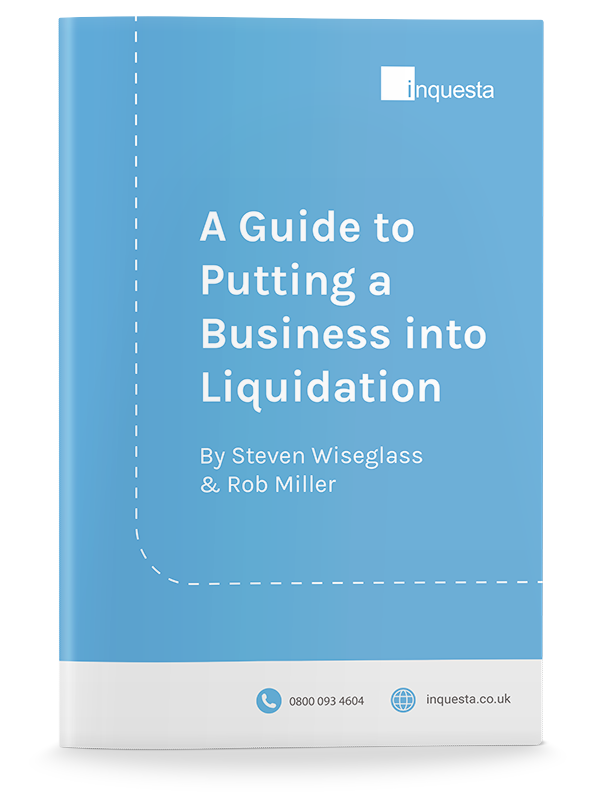What is Corporate Insolvency?
A company is deemed to be insolvent if it is unable to pay its debts as they fall due or if its assets are less than its liabilities. If the problem is acted upon quickly, it may be possible to save the business from collapse. If not, the firm may be forced to close either voluntarily or involuntarily.
Understanding the financial position of your company is essential, as trading whilst insolvent is an extremely serious offence that can carry grave consequences. Should you ever be unsure, you should seek specialist guidance from a licensed insolvency practitioner at your earliest opportunity, as they can carry out an in-depth review of your firm’s liquidity and discuss your options with you.
There are a few ways in which company directors can determine whether or not their firm is solvent. The first is known as the ‘cash flow insolvency test’, which asks whether the business is able to pay its bills whenever they fall due. Potential liabilities involved include PAYE, VAT, National Insurance Contributions, supplier payments, rent and utility charges, and bank loans. If a company consistently finds they do not have enough funds available to satisfy these obligations as they fall due, it may well be insolvent.
Another common way of determining solvency is the ‘balance sheet test’. This involves finding out whether the firm’s assets, including available cash in the bank, are worth more than the debts they owe. If not, the business could be considered to be insolvent. The final method is if a company is facing legal action from their creditors, such as County Court Judgements (CCJs) or Statutory Demands, that it cannot pay.
Should any of the above apply to you, it is important to seek specialist assistance as soon as possible. Contacting a licensed insolvency practitioner and business recovery expert quickly will give you the best possible chance of turning around your fortunes and saving your business, as there will be more options available to you. These options will diminish in number the longer you wait, making liquidation even more inevitable.
Once insolvency has been established, it is important that your company ceases trading immediately and all contracts (both present and future) are terminated. If saving the company is possible, there are a few ways in which this can be achieved. These include administration, a pre-pack sale, a moratorium, administrative receivership, company voluntary arrangements, and schemes of arrangement.
Should recovery not be a viable option, the company will unfortunately need to be closed down via liquidation. An insolvent liquidation is either done voluntarily (provided shareholders and creditors agree to it), or will be forced upon business owners by their creditors in the form of a compulsory winding up order. It is always a good idea to pursue a voluntary liquidation if at all possible, as this will give you a lot more control of the process — such as deciding which liquidator you would like to use.
It is also possible to liquidate a solvent company. There are a number of reasons why a business owner would want to do this, such as if they want to retire, or the firm is no longer required. Closing a solvent company by way of a Members Voluntary Liquidation (MVL) is an extremely popular choice, as it is considered to be the most tax-efficient method for a shareholder to exit a firm.
Even if a struggling company is not yet insolvent, it can still seek expert guidance from a business recovery specialist. They will take a detailed look at all the circumstances involved in the case and outline how they can help.
The Role of an Insolvency Practitioner
A licensed insolvency practitioner has an extremely important and varied role in insolvency cases. From performing an initial review of a firm’s solvency to helping with closing down the business, there are many different ways in which they can assist.
If the insolvency practitioner also happens to be a specialist in business recovery, they will be able to guide their clients through the different options available to them and help them turn around their fortunes if possible. This can be in the form of restructuring their operations or official procedures such as administration or receivership.
While licensed insolvency practitioners will be able to act in an advisory capacity to help business owners with their financial difficulties, their primary responsibility lies with the creditors and ensuring their best interests are served.
Grounds for Winding Up an Insolvent Company
According to the Insolvency Act 1986, there are a number of grounds for winding up an insolvent company. These include:
- The business has decided it should be wound up by way of a special resolution
- The firm is unable to pay its debts
- An application has been made by a firm’s creditors to have the company wound up
- A court has decided it is just and equitable for a business to be wound up
A company will be deemed to be unable to pay its debts if it does not satisfy its obligations, or seek reasonable ways to negotiate with its creditors for a period of three weeks after they have received a written demand from their creditors. This is provided the amount owed is more than £750.
The firm can also be found unable to pay its debts if it can be proved to the court’s satisfaction that the value of its assets is less than the amount of its liabilities, both current and future.
The Corporate Insolvency Process
Understanding the corporate insolvency process is essential, as it is extremely important that everything is followed to the letter. From realising there is a problem and seeking specialist guidance, to either turning around the business or closing it down by way of liquidation, a licensed insolvency practitioner and corporate recovery expert can help you from start to finish.
The main steps of the corporate insolvency process are as follows:
Free eBook: A Guide to Putting a Business into Liquidation
If you believe your business may be in distress, understanding the warning signs early is essential to securing the best possible outcome. In our free guide, we explore the process of putting a business into liquidation, what options you have when it comes to insolvency, the impact liquidation has on stakeholders, and much more.

Key Elements of Limited Company Insolvency & Recovery
There are several important elements when it comes to limited company insolvency and recovery. These range from liquidation and restructuring, to receivership and solvent winding up. Whether each option is available to you depends largely on your individual circumstances, making it essential to seek specialist assistance at your earliest opportunity.
Here are some of your potential options in more detail:
A Company Voluntary Arrangement (CVA) enables a firm to reach an agreement with its creditors about how its debts should be handled or if they can be discharged. It effectively gives the indebted business a chance to restructure its operations without having to resort to the formal insolvency process.
For a CVA to be granted, a company must first of all approach its unsecured creditors and ask them to accept the proposal. If three-quarters or more (in terms of debt value) of creditors who respond to this request are in approval, the CVA will take effect and bind all creditors to the agreement — whether they responded or not. CVAs do not affect secured or preferential creditors, unless they agree to it.
It is also important for an indebted business to seek approval from its own shareholders, where just a simple majority vote in favour (in terms of number) is required. However, even if the shareholders vote against the proposals, a CVA can still go ahead as long as it was approved by the creditors. Once approved, it usually takes over 28 days for a CVA to be in full-effect, as it can still be challenged in court.
Schemes of Arrangement are more sophisticated corporate recovery procedures than CVAs. They have a greater level of involvement with the courts and can even bind secured creditors if sanctioned. The approval of more than 50% in number and 75% in debt value of a firm’s creditors is needed for the motion to pass.
Creditors may need to be divided into separate classes for voting purposes if their rights are deemed to be too different to vote as part of a singular classification. If this happens, a 50% (in number) and 75% (in value) vote in favour is required from each different class for a scheme of arrangement to take effect. However, it may still be possible for the proposals to be given the green light if this requirement is not reached — provided the courts believe the plan will be fair overall.
Because a scheme of arrangement is usually a lot more complicated in nature than a CVA, and requires a considerable amount of time in court, it is usually only used by larger companies.
Introduced in 2020, the corporate restructuring process affords companies in financial stress the opportunity to propose a compromise with its creditors and members to restructure its affairs and operations. It applies to any business that is liable to be wound up under the Insolvency Act 1986, with a similar eligibility test to a scheme of arrangement.
Much like a scheme of arrangement, a corporate restructuring plan must receive the agreement of at least 75% (in terms of value) of creditors and members (or class of them) who attend the meetings either in person or by proxy. There is no requirement for a 50% vote in terms of number, however. Additionally, the procedure enables a court to bind dissenting classes of creditors or members — provided they will be no worse off than alternative scenarios. This process is known as a ‘cross-class cram-down’.
There are two additional hurdles a firm must overcome for a corporate restructuring plan to be granted that are not present for schemes of arrangement. These are:
- It must be in, or is close to being in, financial difficulty which will affect its ability to operate as a going concern
- The corporate restructuring plan must only be used as a way to eliminate or mitigate the potential effects of its financial position
A debt moratorium is designed to give companies in financial difficulty a bit of breathing space so it can pursue a restructuring plan. It offers temporary protection in the form of a payment holiday from some of its debts, and immunity from legal and enforcement action being taken against it for an initial period of 20 business days.
While a debt moratorium allows company directors to remain in control of their firm, a licensed insolvency practitioner is also appointed to oversee the process and provide some safeguards to creditors. In particular, the monitor will be tasked with continuously assessing the business to ensure that rescuing it as a going concern remains a viable option throughout the entire process.
Companies can apply for a debt moratorium to be extended beyond the initial 20 business days if they feel they need it. A further 20 business days can be added to the timeframe without requiring prior approval from creditors, while the process can even be extended to one year if the creditors agree to it. Anything beyond that will need to be permitted by the courts.
Corporate administration gives businesses breathing space to either be rescued, reorganise, or realise their assets to pay creditors. It offers a moratorium on debts being called against them without prior consent from the administrators or the courts. To qualify, companies must have failed the cash flow or balance sheet test, unless the application is made by a floating charge holder.
The main aims of the corporate administration process are:
- Preserve the struggling business as a going concern
- Offer creditors a better return on what they are owed than winding up the company would provide
- Realise the assets of a firm in distress so the proceeds can be distributed to preferential or secured creditors
Although some corporate recovery options allow business owners to remain in full control of their operations, administration involves the appointment of a licensed insolvency practitioner in the role of administrator. They will take over management of the firm and be granted sweeping powers, with their ultimate duty being to act in the best interests of the company’s creditors. The procedure will last for one year unless an extension is agreed.
Company receivership allowed creditors that had a floating charge to appoint an administrative receiver to manage a struggling firm and its assets — selling them if deemed necessary. Administrative receivers had far-reaching powers, however their loyalty remained steadfastly with creditors. Due to a change in the law in 2003, receiverships are now much less-widely used.
An administrative receivership can only be requested by floating charge creditors if the business existed prior to 15th September 2003. For any firm incorporated after this point, creditors will instead need to apply for the company to be put in administration. That being said, company receivership still exists in different guises, which can sometimes be called upon if circumstances allow. This will most commonly be as a fixed charge or law of property act receiver.
A company needs to be liquidated if there is no chance of it being saved or sold as a going concern. It involves closing down the firm and liquidating its assets, with the proceeds being distributed to creditors (in order of priority) and used to pay for the process itself. Anything left over is given to unsecured creditors and shareholders.
Struggling businesses can either be involved in a corporate liquidation on a voluntary or involuntary basis. If a firm is insolvent and cannot pay its debts, directors can opt for a Creditors Voluntary Liquidation (CVL) as long as their shareholders and creditors agree to it. They can then choose a licensed insolvency practitioner to act as a liquidator to oversee the entire process.
A firm’s creditors can also apply for the company to be liquidated by using a winding up order, known as a compulsory liquidation. This effectively takes control of the procedure out of the hands of directors and hands it to the courts, who will appoint the Official Receiver to take a look at the way the firm was operated. The courts will also appoint a liquidator of their choosing.
Company directors can liquidate their business even if it is solvent and able to pay off its debts. This can either be because they wish to retire, or the firm is no longer necessary. Voluntary winding up via a Members Voluntary Liquidation (MVL) is an attractive option as it can be an extremely tax-efficient way to close a company.
Much like a CVL, a MVL will need to be approved by shareholders before it can go ahead. It is also extremely important for directors to be completely confident their firm is solvent, as trying to pursue a MVL while insolvent can have significant consequences.
Our Company Insolvency & Recovery Services
Inquesta’s corporate insolvency and recovery services are designed to assist with a wide range of circumstances, including:

How Inquesta’s Insolvency Service Can Help
If your business is struggling financially, it is important that you seek the assistance of a company that has specialist experience of not just insolvency, but also business recovery. You need to speak to Inquesta.
With decades of experience in providing expert guidance to businesses from all areas of industry, we offer a truly holistic and personalised service that is hard to find anywhere else. We will conduct a thorough review of your individual circumstances to recommend what we believe is the best solution for you, and can take care of the entire process from start to finish — giving you much-needed peace of mind in what is likely to be an incredibly stressful time.
The Inquesta team are experts at all areas of corporate recovery, from administration and CVAs, to restructuring and receiverships. If liquidation is your only viable option, or compulsory liquidation proceedings have already taken place, you can rely on us to help. We can even assist with company bounce back loans, or if you have received communications from creditors such as statutory demands or winding up petitions.
With us, there is no hidden agenda, just a comprehensive service that exists to provide the best possible outcome for our clients. Contact us today for a consultation to find out exactly how we can help.
Get In Touch
Our Specialist Team
We have put together an expert team that can assist with a wide range of company insolvency and recovery situations.

Steven Wiseglass
Director of Insolvency
A co-founder of Inquesta, Steven is a licensed Insolvency Practitioner with over a decade of experience in the field. He is a member of the Insolvency Practitioners Association, Association of Business Recovery Professionals (R3), and his insolvency licence is issued by the Insolvency Practitioners Association. In addition, he sits on the R3 committee of the North West Regional Committee.
Steven specialises in advising directors of small to medium-sized businesses, and has a wealth of expertise in providing the most appropriate advice whatever the firm’s circumstances may be. He has also been instrumental in helping company directors save their business and rebuild them into successful enterprises.
Latest Articles
Does Liquidating a Company Affect Credit Rating?
The decision to liquidate your limited company is often a weighty one arising from financial distress or a prolonged inability to sustain operations. For any UK-based businesses facing insolvency, liquidation can seem like the only [...]
How Does Liquidation Affect Directors?
The path to understanding the many implications of what happens to directors when a company goes into liquidation can be comparable to charting a course through unknown waters. For a director, liquidation can cast a [...]
Can a Director of a Liquidated Company Get a Mortgage
Picture the scene, you’ve poured your heart and soul, as well as years of your life into creating and building a business from the ground up, only to be faced with the bleak reality of [...]









